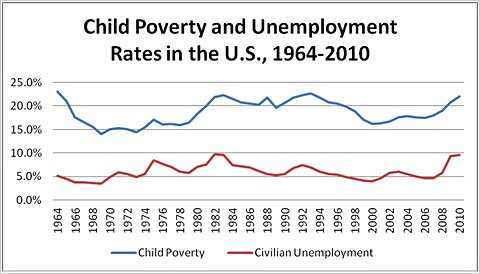 U.S. Census Bureau, Economic Report of the President
U.S. Census Bureau, Economic Report of the President
Nancy Folbre is an economics professor at the University of Massachusetts, Amherst.
Fifteen years have passed since changes in welfare administration imposed tighter restrictions on poor families with children that were seeking cash assistance.
Today’s Economist
Perspectives from expert contributors.
Many Republicans now advocate similar restrictions and cuts in other forms of assistance to the poor on the grounds that they discourage work. Newt Gingrich asserts that janitorial employment for poor children would improve their work ethic.
Yet as the chart above shows, the poverty rate among children now closely follows the unemployment rate, because many parents depend more heavily on paid employment but are unable to find it. (From 1997 to 2010, the correlation between the two rates was 0.78, compared with 0.42 from 1964 to 1996.)
As its name suggests, the Temporary Assistance for Needy Families program, or TANF, established in 1996, was devised on the presumption that mothers who were willing to work would not need more than temporary help. It was never intended to function effectively under conditions of high unemployment.
Indeed, caseloads and outlays in the program have increased much less than those in other forms of public assistance, like food stamps, which have less stringent work requirements. A recent Urban Institute report shows that TANF has proved largely unresponsive to the recession.
The program no longer provides much of a safety net at all. The Center on Budget and Policy Priorities notes that only 27 percent of families in poverty received any cash assistance from TANF in 2009.
Its limited coverage of the poor does not seem to trouble fans of TANF. In a video marking welfare reform’s 15th anniversary, Ron Haskins of the Brookings Institution fails to mention that the child poverty rate now exceeds that of 1996. His only comment on the slow growth of assistance in a period of intense need is, “It makes you wonder.”
Indeed, it makes one wonder whether the real purpose of reform was, as claimed, to help poor families, or simply to minimize spending on them. TANF benefits, adjusted for inflation, are now worth much less than they were in 1996 in most states. They are not sufficient in any state to raise a family’s income above 50 percent of the poverty line.
The much-acclaimed commitment to help poor mothers make a transition to paid employment has also weakened. Arizona and South Carolina have made particularly sharp cuts in child-care subsidies.
Census reports based on the Survey of Income and Program Participation indicate that poor families that pay for child care spent about 40 percent of their income for that purpose in 2010, up from 29 percent in 2005. Expenditures for other families purchasing child care in 2010 was 7 percent.
The combination of child care and other work-related costs, including transportation, further reduce the net benefits of public assistance. Many families may conclude that these benefits are not worth the time, effort and humiliation required to get them. This harsh treatment doesn’t help them find a job.
Welfare reform is in dire need of … reform. A bill recently introduced by Representative Gwen Moore, Democrat of Wisconsin, the Rewriting to Improve and Secure an Exit Out of Poverty Act, would provide permanent funding, modify work requirements so that education and training would qualify, and guarantee child care for TANF work-eligible recipients.
A more likely scenario for the near future is further cuts in TANF spending, driven by fiscal austerity measures that will contribute to persistent unemployment. Pressure to allow extended unemployment benefits to expire puts many children at immediate risk.
A work ethic doesn’t help much when there is no work to be had.
This post has been revised to reflect the following correction:
Correction: December 12, 2011
An earlier version of this post misstated the affiliation of Ron Haskins. He is with the Brookings Institution, not the Urban Institute.
Article source: http://feeds.nytimes.com/click.phdo?i=795b6d2222c4e2f83c53c2fafd8b0a89